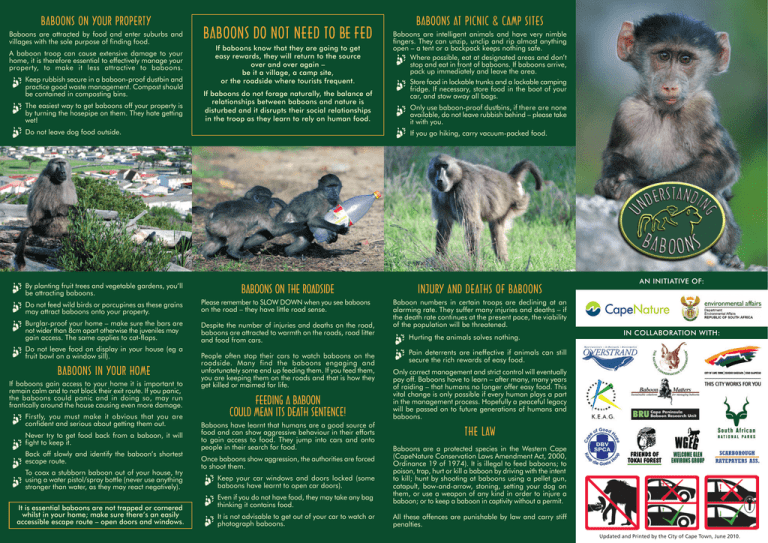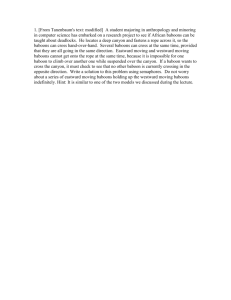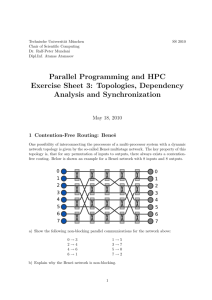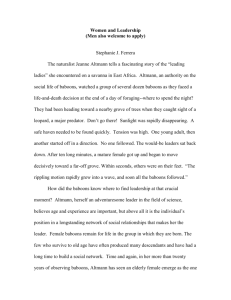BABOONS DO NOT NEED TO BE FED BABOONS ON YOUR PROPERTY
advertisement

BABOONS ON YOUR PROPERTY Baboons are attracted by food and enter suburbs and villages with the sole purpose of finding food. A baboon troop can cause extensive damage to your home, it is therefore essential to effectively manage your property, to make it less attractive to baboons. Keep rubbish secure in a baboon-proof dustbin and practice good waste management. Compost should be contained in composting bins. The easiest way to get baboons off your property is by turning the hosepipe on them. They hate getting wet! BABOONS DO NOT NEED TO BE FED If baboons know that they are going to get easy rewards, they will return to the source over and over again – be it a village, a camp site, or the roadside where tourists frequent. If baboons do not forage naturally, the balance of relationships between baboons and nature is disturbed and it disrupts their social relationships in the troop as they learn to rely on human food. Do not leave dog food outside. By planting fruit trees and vegetable gardens, you’ll be attracting baboons. BABOONS ON THE ROADSIDE Please remember to SLOW DOWN when you see baboons on the road – they have little road sense. Burglar-proof your home – make sure the bars are not wider than 8cm apart otherwise the juveniles may gain access. The same applies to cat-flaps. Despite the number of injuries and deaths on the road, baboons are attracted to warmth on the roads, road litter and food from cars. BABOONS IN YOUR HOME If baboons gain access to your home it is important to remain calm and to not block their exit route. If you panic, the baboons could panic and in doing so, may run frantically around the house causing even more damage. Firstly, you must make it obvious that you are confident and serious about getting them out. Never try to get food back from a baboon, it will fight to keep it. Back off slowly and identify the baboon’s shortest escape route. To coax a stubborn baboon out of your house, try using a water pistol/spray bottle (never use anything stronger than water, as they may react negatively). It is essential baboons are not trapped or cornered whilst in your home; make sure there’s an easily accessible escape route – open doors and windows. Baboons are intelligent animals and have very nimble fingers. They can unzip, unclip and rip almost anything open – a tent or a backpack keeps nothing safe. Where possible, eat at designated areas and don’t stop and eat in front of baboons. If baboons arrive, pack up immediately and leave the area. Store food in lockable trunks and a lockable camping fridge. If necessary, store food in the boot of your car, and stow away all bags. Only use baboon-proof dustbins, if there are none available, do not leave rubbish behind – please take it with you. If you go hiking, carry vacuum-packed food. Do not feed wild birds or porcupines as these grains may attract baboons onto your property. Do not leave food on display in your house (eg a fruit bowl on a window sill). BABOONS AT PICNIC & CAMP SITES People often stop their cars to watch baboons on the roadside. Many find the baboons engaging and unfortunately some end up feeding them. If you feed them, you are keeping them on the roads and that is how they get killed or maimed for life. FEEDING A BABOON COULD MEAN ITS DEATH SENTENCE! Baboons have learnt that humans are a good source of food and can show aggressive behaviour in their efforts to gain access to food. They jump into cars and onto people in their search for food. Once baboons show aggression, the authorities are forced to shoot them. Keep your car windows and doors locked (some baboons have learnt to open car doors). Even if you do not have food, they may take any bag thinking it contains food. It is not advisable to get out of your car to watch or photograph baboons. INJURY AND DEATHS OF BABOONS Baboon numbers in certain troops are declining at an alarming rate. They suffer many injuries and deaths – if the death rate continues at the present pace, the viability of the population will be threatened. Hurting the animals solves nothing. AN INITIATIVE OF: IN COLLABORATION WITH: Pain deterrents are ineffective if animals can still secure the rich rewards of easy food. Only correct management and strict control will eventually pay off. Baboons have to learn – after many, many years of raiding – that humans no longer offer easy food. This vital change is only possible if every human plays a part in the management process. Hopefully a peaceful legacy will be passed on to future generations of humans and baboons. THE LAW Baboons are a protected species in the Western Cape (CapeNature Conservation Laws Amendment Act, 2000, Ordinance 19 of 1974). It is illegal to feed baboons; to poison, trap, hurt or kill a baboon by driving with the intent to kill; hunt by shooting at baboons using a pellet gun, catapult, bow-and-arrow, stoning, setting your dog on them, or use a weapon of any kind in order to injure a baboon; or to keep a baboon in captivity without a permit. All these offences are punishable by law and carry stiff penalties. Updated and Printed by the City of Cape Town, June 2010. UNDERSTANDING BABOONS Baboon troops vary in size from 12 to 150 individuals – sometimes splitting into sub-troops as they forage for food. They form an integral part of the ecology of the Cape Floristic Kingdom, foraging from the coastline to the tops of our highest mountain ranges, dispersing seeds and bulbs as they go. The core of the troop is made up of females: mothers along with their babies and juveniles, grandmothers and sisters. Dominant females ‘inherit’ their social status in the baboon hierarchy from their mothers. In natural conditions, there is one adult male to every three or four adult females in the wild – males move between troops and suffer higher mortality from predators when on their own, or from injuries sustained from males when attempting to join a new troop. ADULT FEMALES & INFANTS All adult females go through stages of pink swelling as part of their reproductive cycle. During the peak of the approximate 17 day cycle she shows a preference to mate with the alpha male. Six months later she will give birth to a single infant (rarely twins) and will care and nurture her baby with great tenderness. Mom and her new arrival are the focus of the troop; she will be fussed over and groomed constantly by those who want a peek at her newborn. Babies are born with a bright pink face and black fur. They cling to their mother’s belly for easy access to milk and protection against the elements. By three months baby learns to ride mom’s back ‘jockey-style’ – a fantastic way to get around and see the world. At this stage they start trying foods such as grass or flowers. They are fully weaned at about one year of age. THE ALPHA MALE The troop is lead by the most dominant adult male – known as the alpha male. A mature male baboon weighs up to 40kg. His is extremely protective over the females and infants within the troop and jealously guards his right to mate with receptive females when they are at the height of their oestrus cycle. He can be a very tender father to his offspring and a formidable fighter against other males hoping to take over his position in the troop. The males ‘yawn’ to show off their canine teeth to other males and their loud ‘wahoo’ bark is also a form of communicating their strength and social position to others. The Urban Baboon JUVENILES Humans have encroached on natural areas as towns expand. With urban sprawl comes animal conflict as the latter are displaced and make for uneasy neighbours. Baboon troops that live close to urban areas have fewer adult males than undisturbed troops. The lack of natural predators suggests that the males are being killed as a result of direct conflict with humans. Lone dispersing males are often seen as 'rogues' and are treated as a threat to humans. It is important to realise that lone males reflect the natural movement of the males between troops which is nature’s way of preventing inbreeding, as males do not mate with their mothers, sisters or aunts. Killing males within troops has much wider implications for it opens the door for new males to immigrate into the troop. When this happens the new male typically kills the previous males’ offspring. One study of an urban troop reported that 53% of all infants born, died within their first year. It was suspected that most of these deaths were due to infanticide. The males engage in this shocking behaviour because without the cost of nursing an infant, females quickly come into oestrus and he is thus able to mate with her sooner than had she raised her infant. Approximately half of most baboon troops are made up of juveniles, so it is normal to see many young in a troop. Juveniles of similar ages tend to hang out together – playing boisterously – so one may get the impression that there are many more than there actually are. Juveniles act as baby-sitters in the troop, often carrying, handling and playing with the younger, newly weaned babies. They will grab and hide with a youngster should a fight break out among the adult males, even though they are hardly bigger themselves. They take their playing and caring tasks very seriously! DISPERSING MALES SUB-ADULTS Unlike females who typically remain in the same troop their entire lives, males disperse when sexually mature to find unrelated females. When alone, male baboons are called transient or dispersing males. During this period he is alone for long periods of time and is extremely vulnerable without the support of others. Sub-adult baboons are often mistaken as mature animals by the public. Although they are braver and more out-going than the juveniles, they still need the protection of the troop. ß triggers great displays of ‘wahooing’ with much chasing and vicious fighting. If the new male succeeds in the ‘take-over’, the troop’s hierarchy is upset and new rivalries and relationships may arise among the females. Females reach adulthood around five years of age; males on the other hand are still adolescent at this age. They undergo a rapid growth spurt, resulting in long gangly legs, and a longer snout with a set of pointy canines. Over the next year or two they will start looking more like fullgrown adult males as their chests and necks fill out and their canines grow long and sharp for the battles ahead.




